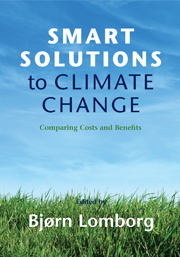Book contents
- Frontmatter
- Contents
- List of figures
- List of tables
- List of contributors
- Acknowledgments
- List of abbreviations and acronyms
- Introduction
- PART I THE SOLUTIONS
- 1 Climate Engineering
- 2 Carbon Dioxide Mitigation
- 3 Forestry Carbon Sequestration
- 4 Black Carbon Mitigation
- 5 Methane Mitigation
- 6 Market- and Policy-Driven Adaptation
- 7 Technology-Led Climate Policy
- 8 Technology Transfer
- PART II RANKING THE OPPORTUNITIES
- Conclusion
- Index
- References
5 - Methane Mitigation
Published online by Cambridge University Press: 05 June 2012
- Frontmatter
- Contents
- List of figures
- List of tables
- List of contributors
- Acknowledgments
- List of abbreviations and acronyms
- Introduction
- PART I THE SOLUTIONS
- 1 Climate Engineering
- 2 Carbon Dioxide Mitigation
- 3 Forestry Carbon Sequestration
- 4 Black Carbon Mitigation
- 5 Methane Mitigation
- 6 Market- and Policy-Driven Adaptation
- 7 Technology-Led Climate Policy
- 8 Technology Transfer
- PART II RANKING THE OPPORTUNITIES
- Conclusion
- Index
- References
Summary
Introduction
Methane (CH4) is a major anthropogenic greenhouse gas (GHG), second only to carbon dioxide (CO2) in its impact on climate change. CH4 has a high global warming potential that is twenty-five times as large as that of CO2 on a 100-year time horizon according to the 2007 IPCC report (IPCC 2007a). Thus, CH4 contributes significantly to anthropogenic radiative forcing, although it has a relatively short atmospheric perturbation lifetime of twelve years. CH4 has a variety of sources that can be small, geographically dispersed, and not related to energy sectors.
In this chapter, we analyze CH4 emission abatement options in five different sectors and identify economic mitigation potentials for different CO2 prices. While mitigation potentials are generally large, there are substantial potentials at low marginal abatement costs (MACs). Drawing on different assumptions on the social costs of carbon (SCC), we calculate benefit-cost ratios (BCRs) for different sectors and mitigation levels.
We recommend an economically efficient global CH4 mitigation portfolio for 2020 that includes the sectors of livestock and manure, rice management, solid waste, coal mine methane, and natural gas. Depending on SCC assumptions, this portfolio leads to global CH4 mitigation levels of 1.5 or 1.9 GtCO2-eq at overall costs of around $14 billion or $30 billion and BCRs of 1.4 and 3.0, respectively. We also develop an economically less efficient alternative portfolio that excludes cost-effective agricultural mitigation options. It leads to comparable abatement levels, but has higher costs and lower BCRs.
- Type
- Chapter
- Information
- Smart Solutions to Climate ChangeComparing Costs and Benefits, pp. 172 - 221Publisher: Cambridge University PressPrint publication year: 2010
References
- 1
- Cited by

